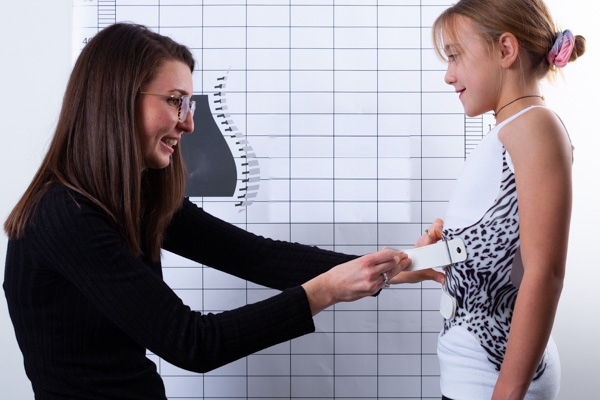Scoliosis affects around three to four children in every 1,000 in the UK and is most often seen in children between the ages of 10 and 15. It is also more common in females than males.
We offer a free initial virtual scoliosis appointment for those seeking scoliosis advice and non-surgical treatment.
This will allow you to talk directly to one of our specialist scoliosis clinicians via a Zoom, Facetime or WhatsApp call.
During this consultation, your clinician will be able to answer any detailed questions or concerns you might have before booking a face-to-face assessment with us.
This free, online consultation will last around 15 minutes. You will need a working camera and microphone for this call.
Anna Courtney, the London Orthotic Consultancy's clinical lead for scoliosis, has a virtual clinic on Monday evenings from 7-9 pm specifically for scoliosis patients seeking treatment.

The purpose of the appointment is to allow you to talk directly to one of our specialist clinicians about your options for scoliosis bracing treatment and how the LOC Scoliosis Brace works.
Your clinician will be able to answer any detailed questions or concerns you might have before booking a face-to-face assessment.
During the virtual appointment, an orthotist will carefully assess your back and advise you if they recommend treatment. If scoliosis treatment is prescribed, you can then arrange a face-to-face assessment.
Before your appointment, we recommend you read through our Scoliosis Frequently Asked Questions to get the most out of your consultation.
Initial face-to-face appointments consist of:
Please bring any X-rays, scans and other information that you feel may be important to your assessment with you.
To allow for a successful consultation, you will be required to remove some clothing. We recommend female patients wear leggings and a crop top and male patients wear tight-fitting shorts or underwear. This is to ensure optimum images can be taken.
Please note that patients under the age of 18 must be accompanied by a parent or legal guardian for all appointments.
As well as our Kingston clinic, we are also able to see scoliosis patients for initial face-to-face assessments at our clinic at Ten Harley Street. (Please note, all follow-up brace fitting appointments must be carried out at our Kingston clinic.)
Please note, it is mandatory for children or adolescent patients (under 18) to be accompanied by a parent or legal guardian during all Zoom, Facetime, and WhatsApp calls. This is to ensure the safety and wellbeing of our patients.
Both the minor and the accompanying adult must acknowledge and consent to this requirement. We reserve the right to terminate assessments if this condition is not met.

“It’s life-changing, my swimming coach has even remarked what a difference my treatment has made" Read how pectus bracing treatment helped to correct Aris' complex chest deformity, involving a combination of pectus excavatum, pectus carinatum and rib flaring.

Cerebral palsy patient Lucas sees significant improvement in his walking after only six months in his new custom Ankle Foot Orthoses (AFOs), designed by Professor Saeed Forghany in our Manchester clinic. Hear how a detailed gait analysis and bespoke AFOs significantly improved Lucas's gait and comfort.

Freddie’s positional plagiocephaly was treated successfully with the LOCBand Lite, going from 11mm to 2mm after four months in his helmet.

Adult club foot (talipes) patient Natasha says, "I cannot stress how amazing my AFOs are and how they have changed so much for me. The support they give me allows me to walk without crutches outside the house for the first time in over fifteen years."

Diagnosed with adolescent idiopathic scoliosis at 14 years old, Polly and mum Zoe looked to the LOC Scoliosis Brace to help her curve and avoid surgery at a later date.

LOC opens its first clinic in Northern Ireland, LOC Belfast, offer non-surgical orthotic treatment for scoliosis, pectus carinatum and pectus excavatum. Here, we will also be able to provide orthotic treatments for a range of adult and paediatric lower limb conditions including cerebral palsy, spina bifida, hypermobility, stroke, post-polio syndrome, and multiple sclerosis.

Mum Natalie shares her experience of having both her identical twins diagnosed with craniosynostosis. Ella and Nina had surgery at Great Ormond Street Hospital before going through cranial remoulding therapy at the London Orthotic Consultancy.

See how a thorough gait analysis and a correctly-fitted, bespoke Reciprocating Gait Orthosis (RGO) helped Ted, a spinal surgery and cancer survivor, improve his rehabilitation and mobility goals, getting him back on his feet again.